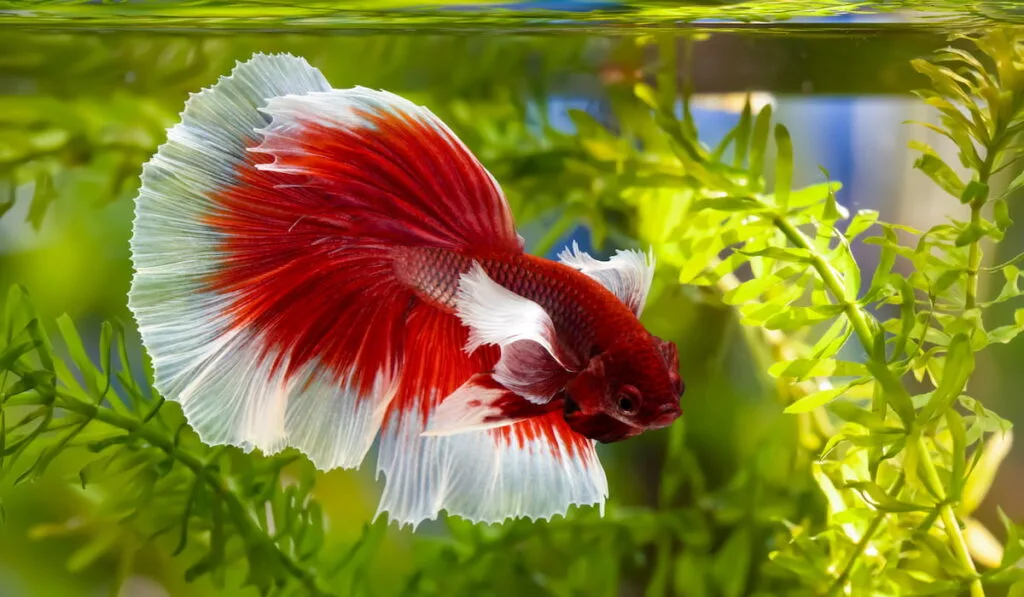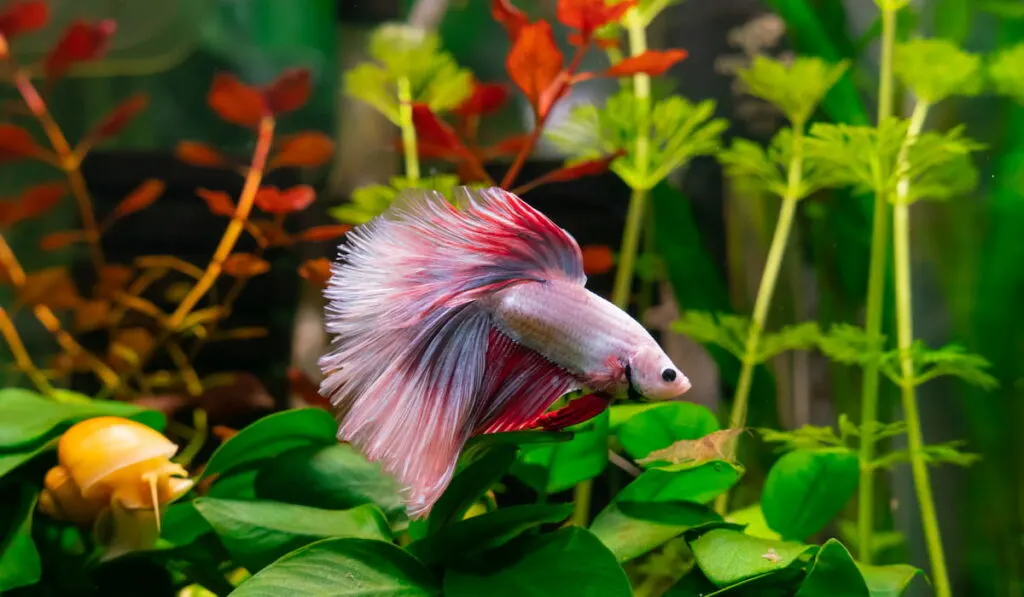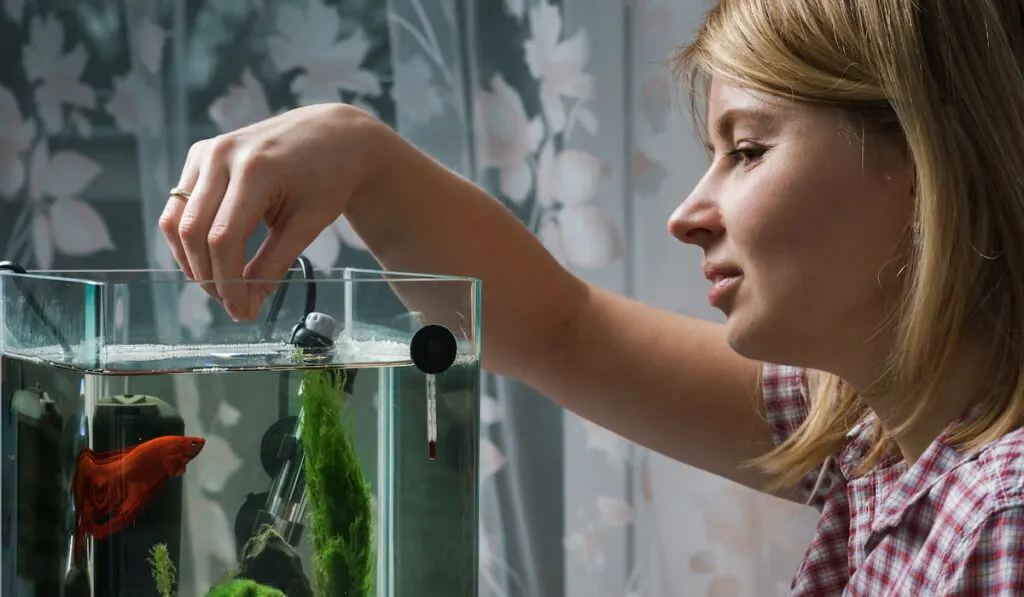Aquariums can make your boring home look exceptionally beautiful. When you introduce a brightly colored betta fish into your aquarium, it does not just enhance the aquarium; betta fish add beauty to your home and can make everyone happier.
Betta fish stand out as attractive because of their brilliant colors. But if you own betta fish, you might start to notice changes in their appearance.
Do betta fish change color?
Betta fish can change their colors because of a gene called the jumping gene. The most popular reasons why betta fish change colors, however, are stress, age, and disease.

Should you be concerned if your betta fish start to change color? What do you need to know about the jumping gene or betta fish care in order to make sure they have a healthy environment?
Let’s take a closer look at betta fish and their unique color changing abilities to better understand how you can provide top care for your fish.
Table of Contents
Why Do Betta Fish Change Color?
Betta fish can change their colors for a number of reasons.
If you are noticing a change in color or dullness in appearance in your own fish, here are the most common (and likely) reasons for the change.
1. Stress
Stress is the most common reason betta fish change their colors. Betta fish colors can become duller if they are experiencing stress. You may also notice a dull strip (called ‘stress strip’) connecting the gills and tail of your fish.
Your betta fish become stressed from bad water quality, overstocking, not having enough space, competition, and incorrect feed. Fortunately, there are things you can do to improve many of these circumstances.
2. Age
Betta fish can live for 2-5 years depending on the care they receive. Usually, betta fish hatch from their eggs and are initially transparent. They develop colors as they age.
Before they are two years of age, their color pattern will be at its brightest. As betta fish continue to age, their color pattern becomes duller.
When the discoloration of betta fish is caused by age, the process occurs slowly. If you notice a quick discoloration of your betta, it could be caused by stress, disease, or other factors.
3. Disease
Various diseases caused by bacteria or fungi present in water can affect the colors of a betta fish. Betta fish can become ill if the water quality is bad or when new organisms (such as fish, plants, or organic water conditioner) are introduced in the water.
Betta fish discoloration can be an indicator of unwanted microbes in the system. If a betta fish has a disease, it is best to isolate it and flush the aquarium water. You should also contact a vet or seek advice from an experienced aquaculture professional.
4. Jumping Gene
Marble coloration is a betta fish mutation that causes the pattern to change or appears as if the pattern is moving. This is caused by jumping genes that can move from one chromosome of a betta fish to another.
These genes are responsible for the pigmentation or coloring of a betta fish, and as they move, so the color patterns of the fish itself.
You do not have to worry if your fish has this mutation. In fact, it is fun to watch. Not every betta fish has the jumping gene, but any fish that has the gene can change its color pattern throughout its life.

How to Maintain Betta Fish Colors
You cannot stop the changing pattern of betta fish that has marble coloration. But you can help prevent your betta fish from losing its colors because of stress, age, or disease.
Here are some tips for how to help your betta fish stay healthy and maintain their colors:
1. Pay Close Attention to Water Quality and Quantity
Water quality greatly affects betta fish. Betta fish are tropical fish, so when you are caring for a betta fish, do not treat it just like fish that are native to temperature regions.
Here are the recommended water quality parameters for betta fish:
- Temperature: Betta fish need warm water. Your aquarium tank should have a temperature of about 70° to 80° F (or 21° to 26° C).
- pH: The importance of pH in an aquarium cannot be overemphasized. Water containing betta fish should have a pH between 6.8 and 7.5.
- Nitrogen: Ammonia, nitrite, and nitrate are usually present in an aquarium. However, ammonia and nitrite are toxic to fish and should always be < 1mg/liter. Nitrate is safe for fish but should not exceed 400mg/liter.
- Dissolved Oxygen: The DO count of aquarium water should always be more than 6 (on a scale of 0-10). This is why an aquarium should always have a bubbler.
If you pay strict attention to your aquarium water quality, your betta fish should be just fine.
2. Separate Male Betta Fish
Male betta fish are aggressive toward each other. Male bettas can also fight with the males of other species. Female betta fish can accept the presence of other females.
You should have just one male fish in a tank (or two if the tank is very large) to prevent them from fighting. Fighting between fish can increase stress for all of the animals in the tank.
3. Be Mindful of Companion Fishes
Some companion fish can pick on the fins of your betta fish causing them to become injured. You should not introduce aggressive fish into an aquarium that holds betta fish.
If possible, introduce just female fishes when a male betta is in an aquarium. This will help reduce the stress the fish experience and maintain their color better over time.
4. They are Not Starter Pets

Betta fish are wonderful pets, but they are not for everyone. You should not buy betta fish as your first pet.
You need some experience in aquaculture and water quality management before you consider owning a betta fish.
There are some mistakes that new fish owners make, such as poor water maintenance or improper equipment, that can increase stress and discolor a betta fish. For very inexperienced owners, this can even result in the fish dying.
How to Brighten Betta Fish Colors
If your betta fish is discolored or has become dull, what can you do to brighten the color or help the fish become more healthy? Keep in mind that male bettas have more vivid colors than female bettas.
Here a few ways to help brighten the color of your betta fish:
1. Make Them Feel at Home
Your aquarium should have stones or pebbles, caves, plants, and other items that can be found in a natural aquatic habitat. When betta fish feel at home, they will be less stressed and brighten their colors.
2. Give Shrimp to Your Betta Fish
Shrimp is rich in carotene, which can help increase the color quality of the animals that eat them. With an extra shrimp diet, your betta fish can brighten their colors once again.
3. Feed Your Betta Fish a Sufficient, Quality Diet

Betta fish are carnivores that eats other animals and animal products. IN the wild, betta fish eat insects, insect larvae, worms, small fish, and small amphibians.
You should not give a fully plant-based diet to your betta fish because it can be an insufficient source of nutrition and ultimately make their color dull and the fish unhealthy.
You can give processed feeds or pellets to your betta fish because they are made with a balanced blend of ingredients that include the right nutrients for their diet. Improving their food source will help to brighten your betta fish.
4. Use Water Conditioners
Water conditioners are products that change the water quality to match what is needed by fish. There are water conditioners that will make the aquarium water exactly how betta fish need it.
While you can search for such products online, you can also use the dried leaves of the Indian almond tree (Terminalia catappa). These leaves naturally regulate the water pH and also introduce organic compounds that can brighten your betta fish color pattern.
Adding dried Indian almond tree leaves also changes the aquarium water to a light-brownish color. If the water becomes too dark, it means that you used too many leaves. You can easily remove some of the leaves and add clean water into the tank to balance this.
Final Thoughts
Betta fish can change colors. You should worry when your betta fish changes color because of stress, disease, or age. You can enjoy the view when your betta fish have the marble coloration. Always remember to check the water quality of your aquarium and make sure your betta fish have a proper diet.
Resources
- https://www.nationalgeographic.com/animals/2018/10/betta-fish-pet-stores-care-mistreatment-news/
- https://pets.thenest.com/bettas-change-color-4520.html
- https://bettasource.com/do-betta-fish-change-color/
- https://www.peta.org/features/never-buy-betta-fish-as-pets-how-siamese-fighting-fish-suffer/
- https://animals.mom.com/brighten-bettas-color-10067.html
